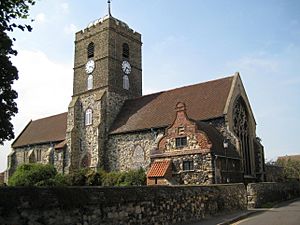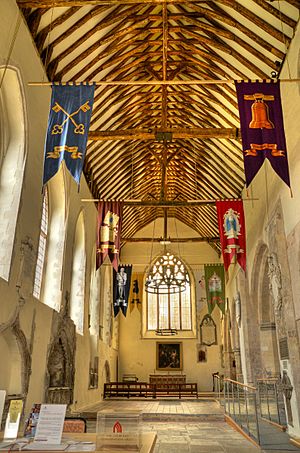St Peter's Church, Sandwich facts for kids
Quick facts for kids St Peter's Church, Sandwich |
|
|---|---|

St Peter's Church, Sandwich, from the southeast
|
|
| Lua error in Module:Location_map at line 420: attempt to index field 'wikibase' (a nil value). | |
| OS grid reference | TR 331 580 |
| Location | Sandwich, Kent |
| Country | England |
| Denomination | Anglican |
| Website | Churches Conservation Trust |
| History | |
| Dedication | Saint Peter |
| Architecture | |
| Functional status | Redundant |
| Heritage designation | Grade I |
| Designated | 19 May 1950 |
| Architect(s) | William White (?) (restoration) |
| Architectural type | Church |
| Style | Gothic |
| Specifications | |
| Materials | Mixture of pebbles, stone rubble, and brick Roofs tiled |
St Peter's Church is a historic Anglican church located in Sandwich, Kent, England. It is no longer used for regular church services, which means it is a redundant church. This special building is protected as a Grade I listed building, meaning it's very important. The Churches Conservation Trust now takes care of it, making sure it stays safe for everyone to visit and learn about.
Contents
A Look Back: Early History of the Church
Building the First Church
Around the year 1100, a Norman church stood on this very spot. This first church was probably destroyed in 1216. That's when French forces attacked the town of Sandwich.
Rebuilding and Changes Over Time
The church was rebuilt during the 1200s. It's thought that Carmelite friars from France helped with this work. At that time, the church had a main area called a nave, with side sections called aisles. It also had a tower and a chancel (the part of the church where the altar is). Below the chancel was a vaulted undercroft, which was likely used as a charnel house (a place to store bones).
During the 1300s, the north aisle was made wider and taller. A special small chapel, called a chantry chapel, was built at the east end of the south aisle. The north porch, which is an entrance area, was added in the 1400s.
The Flemish Community and Later Repairs
In 1560, a group of Flemish Protestants from the Spanish Netherlands came to live in Sandwich. St Peter's Church became their place of worship. Sadly, the church tower fell down in 1661, damaging the south side of the church. The Flemish community rebuilt the tower. They also added a small dome, called a cupola, to the top of the tower.
The church was repaired and updated in the 1800s. In the 1860s, the west end was fixed after a storm. The roofs were re-tiled, and the seating inside was changed. It's believed that the architect William White might have helped with some of these repairs.
Exploring the Church: Architecture and Design
Outside the Church
The church is built using a mix of materials like pebbles, stone rubble, and brick. The roofs are covered with tiles. The church has a main area (nave), a central tower, a chancel, and a north aisle that runs almost the entire length of the building. On the southeast side, there's a two-story room called a vestry.
The tower has three parts. The top two parts were built after the tower collapsed in 1661. They have round-topped windows and openings for bells. There are also clock faces. The top edge of the tower is battlemented, like a castle wall. On top of the tower is the square-domed cupola.
You can see old, blocked-up arches on the south side of the nave and chancel. Above these arches in the nave are 13th-century windows that let light into the church. The south vestry has a curved Dutch gable from the mid-1500s. The undercroft below the vestry has two openings from the 1200s.
The large east window is from the 1300s and is in the Decorated style. There are more Decorated windows in the north aisle, and some windows from the 1600s or 1700s. The north porch, with its battlemented top, is from the 1400s and leads to a 14th-century door. The west door was added in the 1800s.
Inside the Church
Inside, between the nave and the north aisle, there's an arcade with three sections. Another arcade with two sections connects the chancel and the aisle. Both are supported by piers (strong columns).
In the chancel, there's a special three-seat sedilia (seats for the clergy) from the 1200s, and a piscina (a basin for washing sacred vessels). You can also see the royal arms of King Charles II. In the north aisle, there are several tomb recesses from the late 1300s.
The church has a small organ with 173 pipes. Some of these pipes came from an older organ built around 1880. The organ was moved to the nave after being rebuilt. There are eight bells in the tower, all made in 1779. However, they cannot be rung because the tower is not safe. They were last rung (except for the curfew bell) in 1913.
St Peter's Church Today
Changes and New Uses
In 1948, St Peter's Church joined with two other churches in Sandwich: St Mary's and St Clement's. St Clement's became the main church for Sandwich, and St Peter's was no longer used for regular services. From 1952, it was used as a chapel for Sir Roger Manwood's School.
On February 22, 1973, the church was officially declared "redundant." It was then given to the Churches Conservation Trust on April 16, 1974. In the 1990s, a garden was created in what used to be the ruined south aisle. This garden includes a 14th-century window that was moved from another old building in 1923.
Preservation and Community Events
In 2006, the Churches Conservation Trust began a seven-year project to repair and redecorate the church. A group called the Friends of St Peter's helps support the care of the church. Today, the church hosts community events and occasional services. At the west end of the church, there's a display about the Earls of Sandwich.
A very old tradition still continues at St Peter's: the curfew bell is rung from the church every day at 8 PM. The church is open daily for visitors to explore and enjoy its history.
See also


